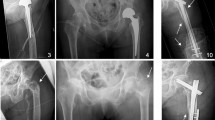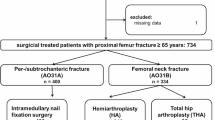Abstract
Introduction
Fragility fractures are a major threat to geriatric patients. However, it is unclear whether this patient population's inherent frailty and comorbidity or the physiologic insult caused by the fracture and its surgery contribute more to undesirable patient outcomes. Hence, this study examines if frailty and comorbidity can predict 30 day postoperative outcomes while the effects of multiple fracture sites are accounted for.
Methods
A retrospective review of patients ≥ 65 years of age in the National Surgical Quality Improvement Program who underwent surgical treatment between 2013 and 2017 was performed. A total of 52,497 patients were included in the final analysis, including fracture cases of the extremities, limbs, and hip. Demographics, several metrics of preoperative health, temporal variables, and fracture location were tested in bivariate analysis of 30 day postoperative mortality, length of stay in hospital, discharge outcome, and complications. Significant variables were considered for multivariate logistic regression models for each outcome.
Results
Frailty, comorbidity, and time to surgery were found to be the significant predictors in multivariate analysis of each 30 day postoperative outcome, independent of the effects of fracture site (p < 0.05). Examination of 30 day mortality found that American Society of Anesthesiologists Class ≥ 3 (2.30 Odds Ratio), modified Frailty Index > 0 (1.37 OR), Charleston Comorbidity Index ≥ 6 (1.63 OR), and time to surgery (1.45 OR) were especially important (all p < 0.05). Additionally, the worst outcomes were associated with fractures of the pelvis/hip and femur/knee, including 30 day mortality (5.90 and 5.12 OR, respectively; both p < 0.05).
Conclusion
The effects of the preoperative health were found to be independent of patient demographics and fracture site. Additionally, specific high-risk fracture sites are significant predictors of outcome, supporting the need to prioritize these patients. Clinical care pathways for geriatric patients may benefit from emphasis on these high-risk fractures and preoperative patient health.

Similar content being viewed by others
Data availability
The ACS-NSQIP datasets are puublically available: https://www.facs.org/quality-programs/data-and-registries/acs-nsqip/participant-use-data-file/.
References
Friedman SM, Mendelson DA (2014) Epidemiology of fragility fractures. Clin Geriatr Med 30:175–181. https://doi.org/10.1016/j.cger.2014.01.001
Brown JP, Adachi JD, Schemitsch E et al (2021) Mortality in older adults following a fragility fracture: real-world retrospective matched-cohort study in Ontario. BMC Musculoskelet Disord 22:105. https://doi.org/10.1186/s12891-021-03960-z
Melton LJ, Achenbach SJ, Atkinson EJ et al (2013) Long-term mortality following fractures at different skeletal sites: a population-based cohort study. Osteoporos Int 24:1689–1696. https://doi.org/10.1007/s00198-012-2225-1
Holt G, Smith R, Duncan K et al (2008) Gender differences in epidemiology and outcome after hip fracture. J Bone Joint Surg Br 90-B:480–483. https://doi.org/10.1302/0301-620X.90B4.20264
Liu LH, Chandra M, Gonzalez JR, Lo JC (2017) Racial and ethnic differences in hip fracture outcomes in men. Am J Manag Care 23:560–564
Ri M, Aikou S, Seto Y (2018) Obesity as a surgical risk factor. Ann Gastroenterol Surg 2:13–21. https://doi.org/10.1002/ags3.12049
Dodd AC, Bulka C, Jahangir A et al (2016) Predictors of 30-day mortality following hip/pelvis fractures. Orthop Traumatol Surg Res 102:707–710. https://doi.org/10.1016/j.otsr.2016.05.016
Crawford ZT, Southam B, Matar R et al (2020) A nomogram for predicting 30-day mortality in elderly patients undergoing hemiarthroplasty for femoral neck fractures. Geriatr Orthop Surg Rehabil 11:2151459320960087. https://doi.org/10.1177/2151459320960087
Glogovac G, Le TT, Archdeacon MT (2020) Time to surgery and patient mortality in geriatric acetabular fractures. J Orthop Trauma 34:310–315. https://doi.org/10.1097/BOT.0000000000001717
Talevski J, Sanders KM, Duque G et al (2019) Effect of clinical care pathways on quality of life and physical function after fragility fracture: a meta-analysis. J Am Med Dir Assoc 20:926.e1-926.e11. https://doi.org/10.1016/j.jamda.2019.02.022
Sheils CR, Dahlke AR, Yang KBA (2016) Are NSQIP hospitals unique? A description of hospitals participating in ACS NSQIP. Academic Surgical Congress Abstracts 21
(2022) Current Procedural Terminology. In: American Medical Association. https://www.ama-assn.org/amaone/cpt-current-procedural-terminology. Accessed 7 Sept 2022
Ariza-Vega P, Jiménez-Moleón JJ, Kristensen MT (2014) Non-weight-bearing status compromises the functional level up to 1 yr after hip fracture surgery. Am J Phys Med Rehabil 93:641–648. https://doi.org/10.1097/PHM.0000000000000075
Sathiyakumar V, Molina CS, Thakore RV et al (2015) ASA score as a predictor of 30-day perioperative readmission in patients with orthopaedic trauma injuries. J Orthop Trauma 29:e127–e132. https://doi.org/10.1097/BOT.0000000000000200
Malik AT, Quatman CE, Phieffer LS et al (2019) Incidence, risk factors and clinical impact of postoperative delirium following open reduction and internal fixation (ORIF) for hip fractures: an analysis of 7859 patients from the ACS-NSQIP hip fracture procedure targeted database. Eur J Orthop Surg Traumatol 29:435–446. https://doi.org/10.1007/s00590-018-2308-6
Bateni SB, Bold RJ, Meyers FJ et al (2018) Comparison of common risk stratification indices to predict outcomes among stage IV cancer patients with bowel obstruction undergoing surgery. J Surg Oncol 117:479–487. https://doi.org/10.1002/jso.24866
Traven SA, Reeves RA, Althoff AD et al (2019) New five-factor modified frailty index predicts morbidity and mortality in geriatric hip fractures. J Orthop Trauma 33:319–323. https://doi.org/10.1097/BOT.0000000000001455
Ravindrarajah R, Hazra NC, Charlton J et al (2018) Incidence and mortality of fractures by frailty level over 80 years of age: cohort study using UK electronic health records. BMJ Open 8:e018836. https://doi.org/10.1136/bmjopen-2017-018836
Åhman R, Siverhall PF, Snygg J et al (2018) Determinants of mortality after hip fracture surgery in Sweden: a registry-based retrospective cohort study. Sci Rep 8:15695. https://doi.org/10.1038/s41598-018-33940-8
Dubljanin-Raspopović E, Marković-Denić L, Marinković J et al (2013) Does early functional outcome predict 1-year mortality in elderly patients with hip fracture? Clin Orthop Relat Res 471:2703–2710. https://doi.org/10.1007/s11999-013-2955-1
Neuhaus V, King J, Hageman MG, Ring DC (2013) Charlson comorbidity indices and in-hospital deaths in patients with hip fractures. Clin Orthop Relat Res 471:1712–1719. https://doi.org/10.1007/s11999-012-2705-9
Lunde A, Tell GS, Pedersen AB et al (2019) The role of comorbidity in mortality after hip fracture: a nationwide Norwegian study of 38,126 women with hip fracture matched to a general-population comparison cohort. Am J Epidemiol 188:398–407. https://doi.org/10.1093/aje/kwy251
Dayama A, Olorunfemi O, Greenbaum S et al (2016) Impact of frailty on outcomes in geriatric femoral neck fracture management: an analysis of national surgical quality improvement program dataset. Int J Surg 28:185–190. https://doi.org/10.1016/j.ijsu.2016.02.087
Krishnan M, Beck S, Havelock W et al (2014) Predicting outcome after hip fracture: using a frailty index to integrate comprehensive geriatric assessment results. Age Ageing 43:122–126. https://doi.org/10.1093/ageing/aft084
Kua J, Ramason R, Rajamoney G, Chong MS (2016) Which frailty measure is a good predictor of early post-operative complications in elderly hip fracture patients? Arch Orthop Trauma Surg 136:639–647. https://doi.org/10.1007/s00402-016-2435-7
Sathiyakumar V, Thakore R, Greenberg SE et al (2015) Risk factors for discharge to rehabilitation among hip fracture patients. Am J Orthop (Belle Mead NJ) 44:E438–E443
Lakomkin N, Kothari P, Dodd AC et al (2017) Higher Charlson comorbidity index scores are associated with increased hospital length of stay after lower extremity orthopaedic trauma. J Orthop Trauma 31:21–26. https://doi.org/10.1097/BOT.0000000000000701
Lee AK, Dodd AC, Lakomkin N et al (2016) Adverse cardiac events in 56,000 orthopaedic trauma patients: does anatomic area make a difference? Injury 47:1856–1861. https://doi.org/10.1016/j.injury.2016.06.013
Schilling PL, Hallstrom BR, Birkmeyer JD, Carpenter JE (2010) Prioritizing perioperative quality improvement in orthopaedic surgery. J Bone Joint Surg 92:1884–1889. https://doi.org/10.2106/JBJS.I.00735
Cohn MR, Cong G-T, Nwachukwu BU et al (2016) Factors associated with early functional outcome after hip fracture surgery. Geriatr Orthop Surg Rehabil 7:3–8. https://doi.org/10.1177/2151458515615916
Nandra R, Pullan J, Bishop J et al (2017) Comparing mortality risk of patients with acute hip fractures admitted to a major trauma centre on a weekday or weekend. Sci Rep 7:1233. https://doi.org/10.1038/s41598-017-01308-z
Bryant EA, Tulebaev S, Castillo-Angeles M et al (2019) Frailty identification and care pathway: an interdisciplinary approach to care for older trauma patients. J Am Coll Surg 228:852-859e1. https://doi.org/10.1016/j.jamcollsurg.2019.02.052
Hubbard RE, Story DA (2015) Does frailty lie in the eyes of the beholder? Heart Lung Circ 24:525–526. https://doi.org/10.1016/j.hlc.2015.01.018
Author information
Authors and Affiliations
Corresponding author
Ethics declarations
Conflict of interest
The authors did not receive support from any organization for the submitted work. The authors have no competing interests to declare that are relevant to the content of this article.
Additional information
Publisher's Note
Springer Nature remains neutral with regard to jurisdictional claims in published maps and institutional affiliations.
Supplementary Information
Below is the link to the electronic supplementary material.
Rights and permissions
Springer Nature or its licensor (e.g. a society or other partner) holds exclusive rights to this article under a publishing agreement with the author(s) or other rightsholder(s); author self-archiving of the accepted manuscript version of this article is solely governed by the terms of such publishing agreement and applicable law.
About this article
Cite this article
Debopadhaya, S., Marmor, M.T. Frailty and comorbidity predict 30 day postoperative outcomes, independent of anatomical site of fracture. Arch Orthop Trauma Surg 143, 4697–4704 (2023). https://doi.org/10.1007/s00402-023-04764-7
Received:
Accepted:
Published:
Issue Date:
DOI: https://doi.org/10.1007/s00402-023-04764-7




